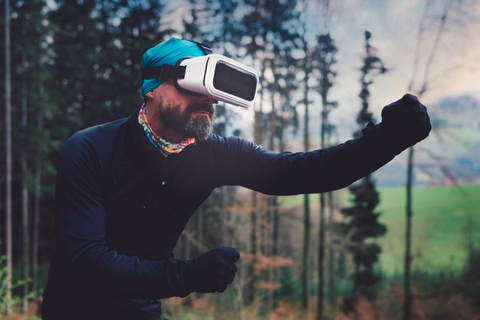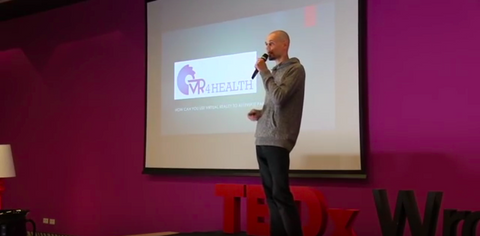Virtual Reality: A Promising Frontier in Phantom Pain Therapy
Individuals who experience phantom limb pain (PLP) may hope for a solution from this breakthrough in virtual reality technology (VR). Eight out of 10 people experience phantom pain, a feeling of discomfort in a hand, arm, or leg that's no longer there. With VR gaining traction beyond the realms of gaming and entertainment, the possibilities are endless.
Ragini Dindukurthi, a freshman from Westview High School in Portland, talked about the future of phantom limb therapy with VR in a jam-packed event for TEDxPortland.
"VR's most common purpose today is for gaming, but imagine if we could use this technology for good," Ragini exclaims.
Phantom Pain in Numbers
In the United States alone, there are 1.9 million people who live with phantom pain, and a total of 507 individuals lose a limb every day. Almost anyone can be affected by this: soldiers, construction workers, and people who have had accidents or even serious infections and frostbite—resulting in 185,000 amputations annually. Imagine this number doubling by the year 2050 because of the rising cases of diabetes and vascular disease. In the end, 80% of these amputees will most likely experience phantom pain.
What Causes Phantom Limb Pain (PLP)?
To this day, it's still quite a mystery as to what causes PLP. Several explanations range from PLP as a psychological problem, while other experts point to the spinal cord and brain as the culprits. Magnetic resonance imaging (MRI) or positron emission tomography (PET) scans indicate some parts of the brain—which used to be neurologically connected to the nerves of the amputated limb—that produce activity as the patient experiences phantom pain.
Bo Geng, PhD., Assistant Professor at the Faculty of Medicine at Aalborg University in Denmark, explains,
"The tactile representation of different body parts are arranged in the brain in a sort of map. If the brain no longer receives feedback from an area, it tries to reprogram its signal reception map. That is the most common conception of how phantom limb pain occurs."
Patients who have more luck recover from PLP with zero treatment over time. For others, this phenomenon can be quite challenging, because how can one treat pain from a limb that's no longer there?
Phantom Limb Pain Symptoms—Do you have it?
Many amputees claim that their missing limb seems to be there, despite having undergone amputation surgery. Bear in mind that this is completely different from phantom limb sensation, which may manifest rarely in individuals who were naturally born without limbs.
More common symptoms include:
- Occurrence within the first few days from amputation
- Pain can come and go at times, or continuous for others
- Often occurs in the part of the limb that's farthest from the body (i.e., hand of an amputated arm)
- Sensation can be shooting, stabbing, boring, squeezing, throbbing, or burning
- Patient can sometimes feel as if the phantom limb is placed in an uncomfortable position
- Pressure or emotional stress can trigger the pain in the remaining part of the limb
Two Other Treatment Options for PLP Therapy
Mirror Therapy

Mirror Therapy is a traditional treatment option in the early 90s using a mirror box that was developed by Vilayanur S. Ramachandran. The patient positions their "good" limb on one side and the remaining on the other. They are made to focus on the side with the functional limb and make "mirror symmetric" movements that are similar to how we clap our hands. Since the individual sees the reflection of the good limb in motion, it gives the phantom limb the illusion of movement as well.
Visual Image Therapy
Visual Image Therapy uses a process similar to Mirror Therapy that requires patients to imagine their missing limb without using a mirror box. The idea was that over time, amputees would retrain their brain, with the treatment eventually easing the discomfort.
Both types of treatment "have only had moderate success and have no formal trials. But what if we could use VR instead of a mirrored box? We could bring up a better representation of a missing limb, without having to rely on our imagination or a mirrored box," explains Ragini.
How Virtual Reality Works in Phantom Limb Pain Therapy

Olaf Blanke, Switzerland
Several researchers have tried VR as a form of therapy for phantom limb pain patients. Olaf Blanke, a neuroscientist from Switzerland, gathered his team of scientists to show the effectiveness of virtual reality.
"We managed to provoke an illusion: the illusion that the subject's legs were being lightly tapped, when in fact the subject was actually being tapped on the back, above the spinal cord lesion", and "when we did this, the subjects also reported that their pain had diminished," he says.
Olaf explains that restoring an individual's sense of touch through VR may be the key for pain relief in patients.
The patient wore VR goggles and saw the dummy legs from above, as if looking down on one's own legs. A camera filmed the legs, while the video fed into the goggles in real time. The scientist then tapped the patient's back with one rod and poked the dummy legs at the same time with another.
This experimental set-up tricks the brain into thinking that the movement comes from the paralyzed limbs, which only goes to show the power of our minds, and the potential of how VR can help ease phantom limb pain.
Max Ortiz Catalan, PH.D., Chalmers University of Technology in Sweden
Ortiz Catalan and his colleagues created a therapy program that uses augmented reality, and tried it on 14 people with amputated arms, one of which was a man who did not respond to treatment in the past. In the first study, Ortiz and his team gathered the most difficult cases from several clinics.
“We wanted to focus on patients with chronic phantom limb pain who had not responded to any treatments. Four of the patients were constantly medicated, and the others were not receiving any treatment at all because nothing they tried had helped them. They had been experiencing phantom limb pain for an average of 10 years,” he says.
These patients had 12, 2-hour treatment sessions, and at the end of therapy the patients reported that their pain had decreased by approximately 50%.
In the other study, the man's virtual arm moved due to electrodes that were recorded from muscle signals in the residual limb, which led to the patient thinking about moving his missing limb. He was able to control the virtual arm and used it to drive a simulated car in a racing game.
Over the course of his treatment, the man reported that his pain gradually subsided. Ortiz says that the new VR therapy would be "more fun and engaging", and that the hope is for this treatment to be available for home use, especially to those who have restricted mobility. His team released 2 types of treatment—a "clinically friendly version, along with an open-source version that developers could integrate into commercial headsets."
The next plan of Ortiz's team involves leg amputees, with more than 30 patients from all over the world expected to participate.
Ortiz explains, “Our joint project was incredibly rewarding, and we now intend to go further with a larger controlled clinical trial. The control group will be treated with one of the current treatment methods for phantom limb pain. This time we will also include leg amputees.”
Bo Geng, China Rehabilitation Research, Beijing
Bo states that virtual reality has a "much better chance of creating a convincing alternative reality". In her new method, patients had to wear VR goggles and a glove, while small electrodes were placed on their residual limbs.
They stimulated the residual limb with small electrical signals which tried to mimic the feeling of a phantom hand. The patient then performed a number of different VR games that involved identical actions with both hands.
Bo administered her first clinical test at the China Rehabilitation Research in Beijing last fall of 2016. Two out of 3 amputees experienced an improvement in PLP, while the 3rd patient's PLP attacks decreased.
Hope in Virtual Reality (VR)
VR gives us the freedom to go beyond the confines of our bedrooms, desks, and homes. It allows us to create a world that's not really there, including hands, legs, or arms that used to be part of us.
There are quite a few challenges that come with this exciting technology: there are no formal trials for VR therapy and the cost for testing is far too expensive. For instance, Oculus Rift, VR’s most popular classes, was slated for $8,000 back in 2017. Cheaper options are available, but may not be as effective. Ragini from TEDxPortland gives 2 recommendations to help increase the viability of this treatment option:
"I would like these formal trials to include a control group, tracking multiple patient variables, different environments, and a larger pool of patients. The more information that we can gather, the more we can improve. If you want to pursue VR therapy for phantom limb pain, then VR companies need to achieve an economy of scale to drive market prices down. VR may be an alluring cure for boredom, but what if it could be a cure for something greater?"

Another front runner in a TED conference in 2016 is Marcin Czub – the principal investigator in VR4Health, a research project on virtual reality and its aid in pain alleviation. He says that 64% of patients that suffer from chronic pain are not satisfied with the effects medications.
Researchers already began tapping the potential of VR as a possible solution for easing pain. A year later, scientists now see it as a viable option for helping with something greater—PLP. There is a foreseeable future in VR as a promising frontier in PLP studies, with companies like Oculus Rift, HTC, Sony, Samsung, LG, and others having made virtual reality headsets available commercially.










































































